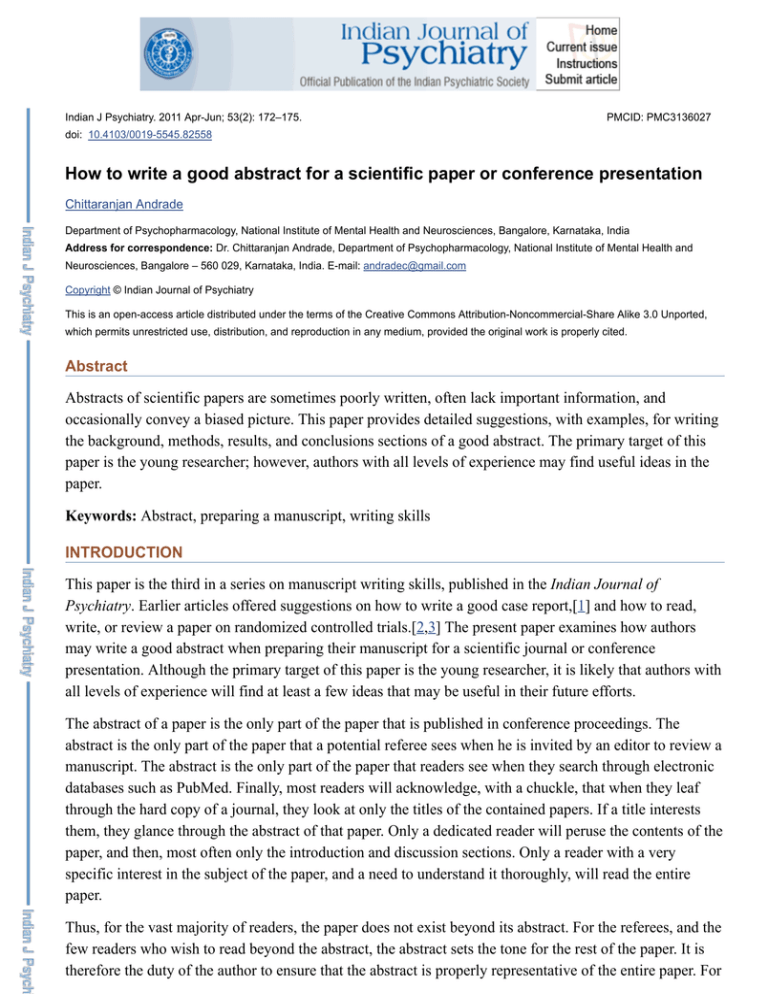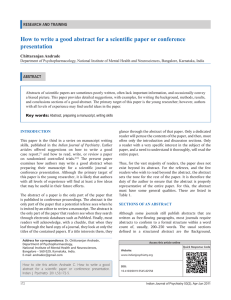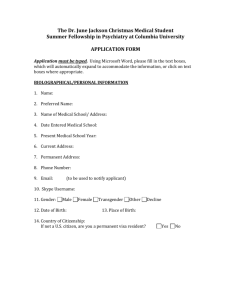How to write a good abstract for a scientific paper
advertisement

Indian J Psychiatry. 2011 Apr-Jun; 53(2): 172–175. PMCID: PMC3136027 doi: 10.4103/0019-5545.82558 How to write a good abstract for a scientific paper or conference presentation Chittaranjan Andrade Department of Psychopharmacology, National Institute of Mental Health and Neurosciences, Bangalore, Karnataka, India Address for correspondence: Dr. Chittaranjan Andrade, Department of Psychopharmacology, National Institute of Mental Health and Neurosciences, Bangalore – 560 029, Karnataka, India. E-mail: andradec@gmail.com Copyright © Indian Journal of Psychiatry This is an open-access article distributed under the terms of the Creative Commons Attribution-Noncommercial-Share Alike 3.0 Unported, which permits unrestricted use, distribution, and reproduction in any medium, provided the original work is properly cited. Abstract Abstracts of scientific papers are sometimes poorly written, often lack important information, and occasionally convey a biased picture. This paper provides detailed suggestions, with examples, for writing the background, methods, results, and conclusions sections of a good abstract. The primary target of this paper is the young researcher; however, authors with all levels of experience may find useful ideas in the paper. Keywords: Abstract, preparing a manuscript, writing skills INTRODUCTION This paper is the third in a series on manuscript writing skills, published in the Indian Journal of Psychiatry. Earlier articles offered suggestions on how to write a good case report,[1] and how to read, write, or review a paper on randomized controlled trials.[2,3] The present paper examines how authors may write a good abstract when preparing their manuscript for a scientific journal or conference presentation. Although the primary target of this paper is the young researcher, it is likely that authors with all levels of experience will find at least a few ideas that may be useful in their future efforts. The abstract of a paper is the only part of the paper that is published in conference proceedings. The abstract is the only part of the paper that a potential referee sees when he is invited by an editor to review a manuscript. The abstract is the only part of the paper that readers see when they search through electronic databases such as PubMed. Finally, most readers will acknowledge, with a chuckle, that when they leaf through the hard copy of a journal, they look at only the titles of the contained papers. If a title interests them, they glance through the abstract of that paper. Only a dedicated reader will peruse the contents of the paper, and then, most often only the introduction and discussion sections. Only a reader with a very specific interest in the subject of the paper, and a need to understand it thoroughly, will read the entire paper. Thus, for the vast majority of readers, the paper does not exist beyond its abstract. For the referees, and the few readers who wish to read beyond the abstract, the abstract sets the tone for the rest of the paper. It is therefore the duty of the author to ensure that the abstract is properly representative of the entire paper. For this, the abstract must have some general qualities. These are listed in Table 1. SECTIONS OF AN ABSTRACT Although some journals still publish abstracts that are written as free-flowing paragraphs, most journals require abstracts to conform to a formal structure within a word count of, usually, 200–250 words. The usual sections defined in a structured abstract are the Background, Methods, Results, and Conclusions; other headings with similar meanings may be used (eg, Introduction in place of Background or Findings in place of Results). Some journals include additional sections, such as Objectives (between Background and Methods) and Limitations (at the end of the abstract). In the rest of this paper, issues related to the contents of each section will be examined in turn. Background This section should be the shortest part of the abstract and should very briefly outline the following information: 1. What is already known about the subject, related to the paper in question 2. What is not known about the subject and hence what the study intended to examine (or what the paper seeks to present) In most cases, the background can be framed in just 2–3 sentences, with each sentence describing a different aspect of the information referred to above; sometimes, even a single sentence may suffice. The purpose of the background, as the word itself indicates, is to provide the reader with a background to the study, and hence to smoothly lead into a description of the methods employed in the investigation. Some authors publish papers the abstracts of which contain a lengthy background section. There are some situations, perhaps, where this may be justified. In most cases, however, a longer background section means that less space remains for the presentation of the results. This is unfortunate because the reader is interested in the paper because of its findings, and not because of its background. A wide variety of acceptably composed backgrounds is provided in Table 2; most of these have been adapted from actual papers.[4–9] Readers may wish to compare the content in Table 2 with the original abstracts to see how the adaptations possibly improve on the originals. Note that, in the interest of brevity, unnecessary content is avoided. For instance, in Example 1 there is no need to state “The antidepressant efficacy of desvenlafaxine (DV), a dual-acting antidepressant drug, has been established…” (the unnecessary content is italicized). Methods The methods section is usually the second-longest section in the abstract. It should contain enough information to enable the reader to understand what was done, and how. Table 3 lists important questions to which the methods section should provide brief answers. Carelessly written methods sections lack information about important issues such as sample size, numbers of patients in different groups, doses of medications, and duration of the study. Readers have only to flip through the pages of a randomly selected journal to realize how common such carelessness is. Table 4 presents examples of the contents of accept-ably written methods sections, modified from actual publications.[10,11] Readers are invited to take special note of the first sentence of each example in Table 4; each is packed with detail, illustrating how to convey the maximum quantity of information with maximum economy of word count. Results The results section is the most important part of the abstract and nothing should compromise its range and quality. This is because readers who peruse an abstract do so to learn about the findings of the study. The results section should therefore be the longest part of the abstract and should contain as much detail about the findings as the journal word count permits. For example, it is bad writing to state “Response rates differed significantly between diabetic and nondiabetic patients.” A better sentence is “The response rate was higher in nondiabetic than in diabetic patients (49% vs 30%, respectively; P<0.01).” Important information that the results should present is indicated in Table 5. Examples of acceptably written abstracts are presented in Table 6; one of these has been modified from an actual publication.[11] Note that the first example is rather narrative in style, whereas the second example is packed with data. CONCLUSIONS This section should contain the most important take-home message of the study, expressed in a few precisely worded sentences. Usually, the finding highlighted here relates to the primary outcome measure; however, other important or unexpected findings should also be mentioned. It is also customary, but not essential, for the authors to express an opinion about the theoretical or practical implications of the findings, or the importance of their findings for the field. Thus, the conclusions may contain three elements: 1. The primary take-home message 2. The additional findings of importance 3. The perspective Despite its necessary brevity, this section has the most impact on the average reader because readers generally trust authors and take their assertions at face value. For this reason, the conclusions should also be scrupulously honest; and authors should not claim more than their data demonstrate. Hypothetical examples of the conclusions section of an abstract are presented in Table 7. MISCELLANEOUS OBSERVATIONS Citation of references anywhere within an abstract is almost invariably inappropriate. Other examples of unnecessary content in an abstract are listed in Table 8. It goes without saying that whatever is present in the abstract must also be present in the text. Likewise, whatever errors should not be made in the text should not appear in the abstract (eg, mistaking association for causality). As already mentioned, the abstract is the only part of the paper that the vast majority of readers see. Therefore, it is critically important for authors to ensure that their enthusiasm or bias does not deceive the reader; unjustified speculations could be even more harmful. Misleading readers could harm the cause of science and have an adverse impact on patient care.[12] A recent study,[13] for example, concluded that venlafaxine use during the second trimester of pregnancy may increase the risk of neonates born small for gestational age. However, nowhere in the abstract did the authors mention that these conclusions were based on just 5 cases and 12 controls out of the total sample of 126 cases and 806 controls. There were several other serious limitations that rendered the authors’ conclusions tentative, at best; yet, nowhere in the abstract were these other limitations expressed. As a parting note: Most journals provide clear instructions to authors on the formatting and contents of different parts of the manuscript. These instructions often include details on what the sections of an abstract should contain. Authors should tailor their abstracts to the specific requirements of the journal to which they plan to submit their manuscript. It could also be an excellent idea to model the abstract of the paper, sentence for sentence, on the abstract of an important paper on a similar subject and with similar methodology, published in the same journal for which the manuscript is slated. Footnotes Source of Support: Nil Conflict of Interest: None declared. REFERENCES 1. Andrade C, Mendhekar DN. Lithium, trifluperazine, and idiopathic leucopenia: Author and reviewer perspectives on how to write a good case report. Indian J Psychiatry. 2010;52:187–90. [PMCID: PMC2927891] [PubMed: 20838509] 2. Andrade C. A 6-week, multicentre, randomized controlled clinical trial to evaluate the safety and efficacy of placeboxetine hydrochloride in the treatment of major depressive disorder in an Indian setting. Indian J Psychiatry. 2011;53:69–72. [PMCID: PMC3056193] [PubMed: 21431013] 3. Andrade C. Placeboxetine for major depressive disorder: Researcher, author, reader, and reviewer perspectives on randomized controlled trials. Indian J Psychiatry. 2011;53:73–7. [PMCID: PMC3056194] [PubMed: 21431014] 4. Andrade C, Radhakrishnan R. Prayer and healing: A medical and scientific perspective on randomized controlled trials. Indian J Psychiatry. 2009;51:247–53. [PMCID: PMC2802370] [PubMed: 20048448] 5. Shah N, Mahadeshwar S, Bhakta S, Bhirud M, Fernandes P, Andrade C. The safety and efficacy of benzodiazepine-modified treatments as a special form of unmodified ECT. J ECT. 2010;26:23–9. [PubMed: 20190597] 6. Andrade C, Srihari BS, Reddy KP, Chandramma L. Melatonin in medically ill patients with insomnia: a double-blind, placebo-controlled study. J Clin Psychiatry. 2001;62:41–5. [PubMed: 11235927] 7. Andrade C, Madhavan AP, Kishore ML. Testing logical memory using a complex passage: Development and standardization of a new test. Indian J Psychiatry. 2001;43:252–6. [PMCID: PMC2956151] [PubMed: 21407864] 8. Andrade AC, Pai S, Cardoza S, Andrade C. Personality profile of urban, female college students. Indian J Psychol Med. 1994;17:41–6. 9. Andrade C, Postma K, Abraham K. Influence of women's work status on the well-being of Indian couples. Int J Soc Psychiatry. 1999;45:65–75. [PubMed: 10443250] 10. Kumar CN, Andrade C, Murthy P. A randomized, double-blind comparison of lorazepam and chlordiazepoxide in patients with uncomplicated alcohol withdrawal. J Stud Alcohol Drugs. 2009;70:457– 74. 11. Margoob MA, Ali Z, Andrade C. Efficacy of ECT in chronic, severe, antidepressant- and CBTrefractory PTSD: An open, prospective study. Brain Stimul. 2010;3:28–35. [PubMed: 20633428] 12. Rao TS, Andrade C. The MMR vaccine and autism: Sensation, refutation, retraction, and fraud. Editorial. Indian J Psychiatry. 2011;53:95–6. [PMCID: PMC3136032] 13. Ramos I, St-Andri M, Birard A. Association between antidepressant use during pregnancy and infants born small for gestational age. Can J Psychiatry. 2010;55:643–52. [PubMed: 20964943] Figures and Tables Table 1 General qualities of a good abstract Table 2 Examples of the background section of an abstract Table 3 Questions regarding which information should ideally be available in the methods section of an abstract Table 4 Examples of the methods section of an abstract Table 5 Information that the results section of the abstract should ideally present Table 6 Examples of the results section of an abstract Table 7 Examples of the conclusions section of an abstract Table 8 Examples of unnecessary content in a abstract Articles from Indian Journal of Psychiatry are provided here courtesy of Medknow Publications



